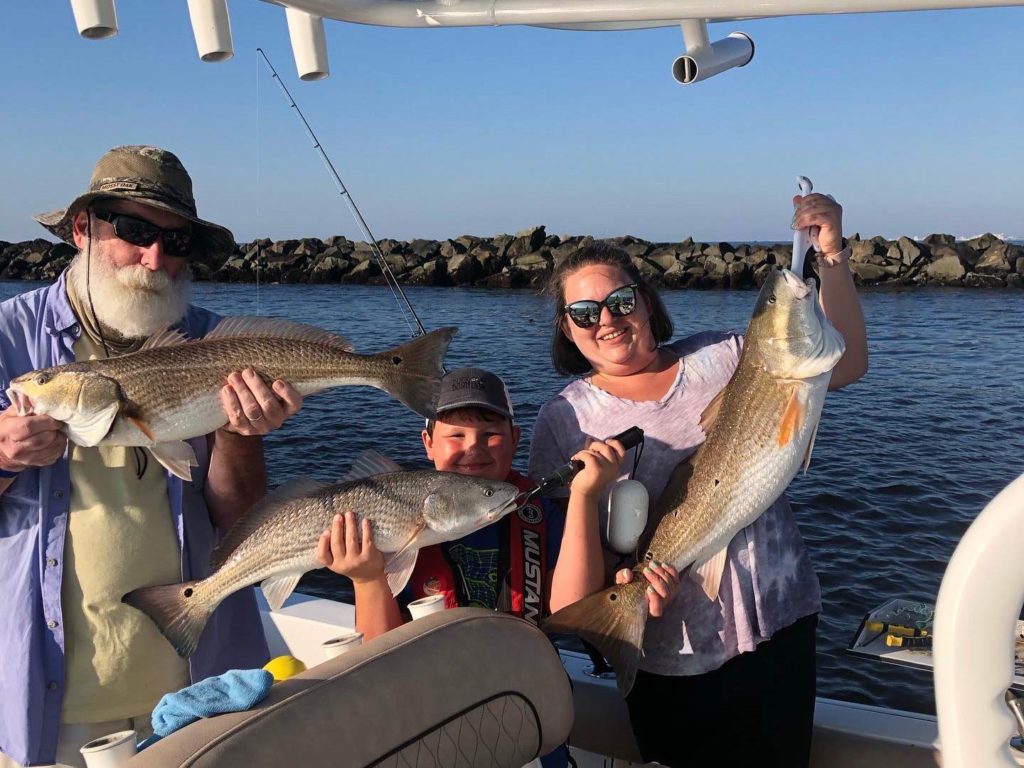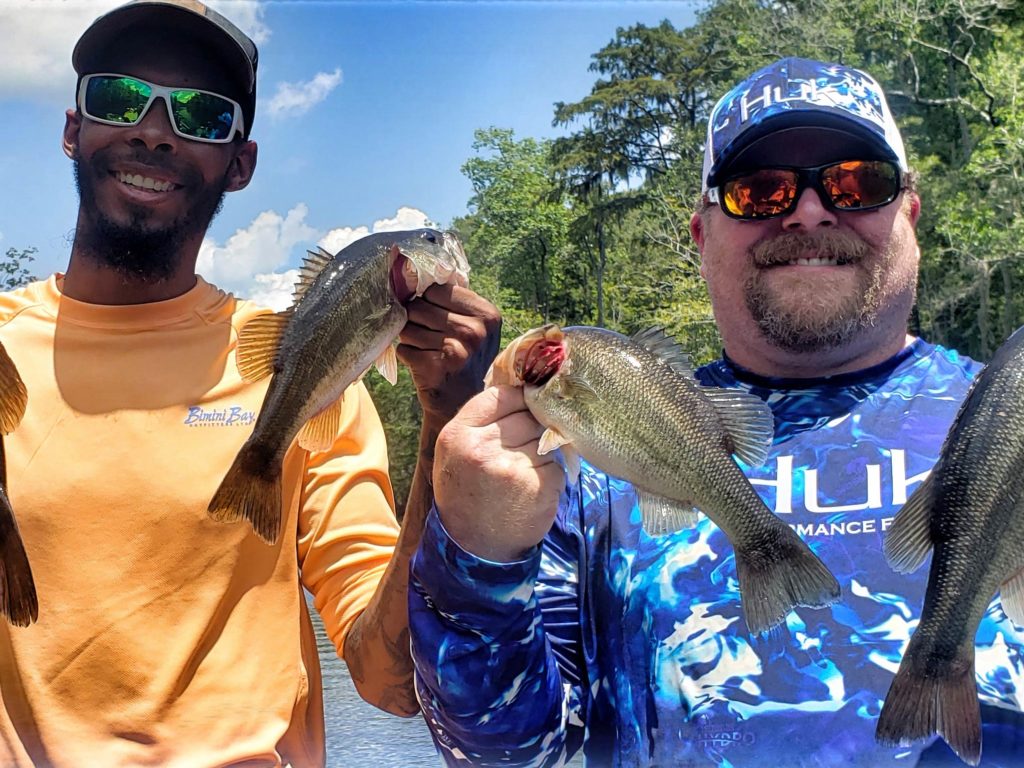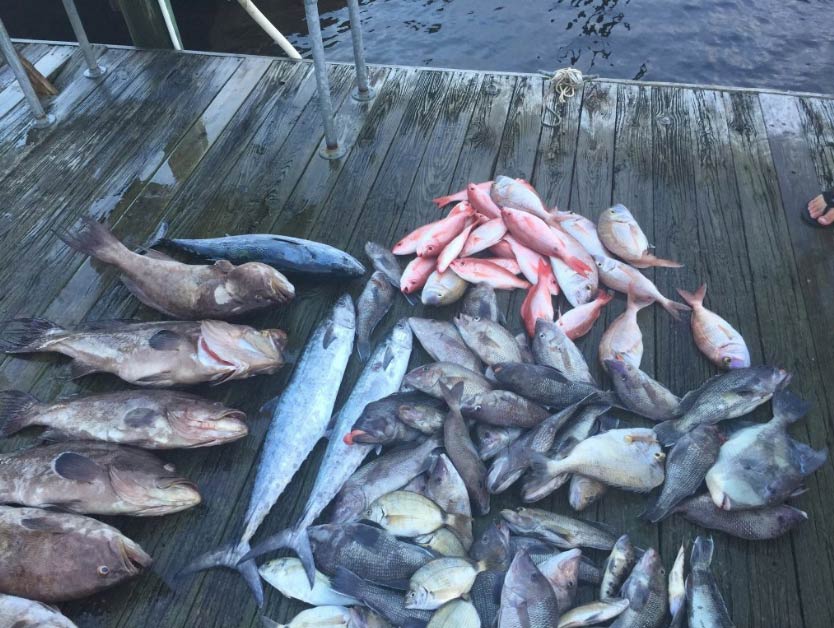Almost five decades after four communities blended into one city, North Myrtle Beach continues to flourish. Firstly, it’s a great tourist destination on the Grand Strand with its nine-mile-long beach. Secondly, it’s one of the best angling spots on the East Coast. Yes, fishing in North Myrtle Beach is nothing short of great.

So, what do anglers get in North Myrtle Beach? From easy access to the Gulf Stream and deep seas of the Atlantic Ocean to the inland marshes, backwater creeks, and the Intracoastal Waterway, your choice is impressively broad. You can enjoy some family fun inshore or take your adventure to the bluewater fishing grounds. You can even try it all over one weekend.
This guide will help you decide what fishing species to look for, which spots to check out first, and when’s the best time to go fishing in North Myrtle Beach. Let’s begin with the top catches in the inshore, nearshore, and offshore waters.
What can I catch while fishing in North Myrtle Beach?
Inshore
North Myrtle Beach’s inshore fishing grounds include a generous variety of spots. Anglers can explore beaches, piers, rocky shorelines, backwater creeks, inlets, jetties, estuaries, flats, and islands.
The inshore waters are usually calm, so fishing season here is possible pretty much year-round. But it all depends, of course, on which exact species you’re after. Let’s talk about the top three inshore targets in North Myrtle Beach.
Black Drum

Black Drum are residents of the deep inlet channels in early spring and late fall when the water is warming up. In summer, they move to deeper waters, so you might want to take your trip further toward the nearshore waters. Meanwhile, in the fall, you can find them in shallow grass.
In general, Black Drum hang out around muddy bottoms and in the shallows. If you’re fishing from a boat, it’s always a good idea to head out to an oyster bed during some tidal movement. A lot of North Myrtle Beach anglers also fish for them along the stone walls of the Little River Inlet and jetties.
Black Drum fishing is a light tackle game. A typical combo would be a 7′ spinning rod with a 15 lb test line. Natural fresh bait is the best choice – live shrimp, small pinfish, and mud minnows work well.
Keep in mind that there are specific regulations you need to follow if you’re keeping your catch. According to the SDNR, you can keep five Black Drum per person per day, within a 14–27 inch limit.
Redfish

Similar to Black Drum, the success of Redfish fishing in North Myrtle Beach heavily depends on the tides. In general, mornings are the best for young Reds, especially if you’re planning a spring or summer trip.
Younger fish hang out near the edge of marsh grasses and estuaries, snacking on minnows and crabs. Adult Reds, on the other hand, feed on sandy bottoms, oyster beds, and tidal creeks. Head to a jetty and look for a drop-off if you’re fishing from a boat, or cast in grass flats if you’re wading.
If you’re planning to target Redfish, feel free to pack your light tackle gear. A spinning rod with a 20 lb test line should do the trick, along with live bait or artificial lures. There is a limit of two fish per person per day. As for size limits, you can only keep “slot Redfish” within a 15–23 inch limit.
If you’re lucky, you can also hook into a Bull Redfish, over 39 inches. You’ll need to release those back into the water, too.
Spotted Seatrout

Our top North Myrtle Beach inshore species list wouldn’t be complete without Spotted Seatrout. These beautiful creatures are in the area all year round. However, only local Spotted Seatrout anglers know where are the best places to find them.
During summer, you can look for fish in the lower parts of the estuaries. Oyster bars, pilings, rocks, and other areas with the structure are perfect for a spring or fall trip. Anglers sometimes cast artificial lures for Seatrout, although live bait works best in the summer months.
You won’t need heavy tackle to fish for Spotted Seatrout, either. You can fish your bait from a float rig or on the bottom with a slip sinker and a 20 lb test monofilament leader. The Seatrout limit is pretty generous – you’re allowed to keep ten fish per person per day with a maximum total length of 14 inches.
Nearshore
While it’s hard enough already to draw up a list of potential inshore catches, the nearshore waters offer even more fish. Spanish Mackerel, Barracuda, Bluefish, and other exciting species patrol the waters within ten miles of shore. There are, however, certain species that hold a special place on the nearshore fishing menu.
Sharks

We’re talking about Sharks, of course! There are multiple spots up and down the Grand Strand that are perfect for a Shark expedition. Such trips are reserved for the summer and early fall. If you’re after the biggest catch around, head out anytime in June, July, and August.
To catch Sharks, you don’t need to book a full-day charter. A shorter, four-hour trip is more than enough to get your hands on whatever’s willing to bite. The Shark menu includes Dog, Blacktip, Dusky, Tiger, Spinner, and Bull Sharks. These species are bigger than your average inshore catch. Some Sharks weigh up to 300 pounds and are in the 4–6′ range.
Live and dead bait are essential if you’re looking for a successful trip. Some anglers also use flies and artificial lures, so you might want to check with your captain about what kind of bait to expect before the trip. As well as that, get ready to release all Sharks back into the water alive and unharmed. While you’re allowed to keep certain Shark species, catch-and-release is standard practice.
Offshore

Offshore and deep sea fishing in North Myrtle Beach offers all sorts of possibilities. You can venture anywhere from 20 up to 80 miles into the blue waters of the Gulf Stream. In fact, some captains go even further out.
The further you go, the bigger the fish you can expect. Wahoo, Mahi Mahi, Blackfin and Yellowfin Tuna, Marlins, Snapper, Grouper – anything is in the cards here. The bounty of the Gulf Stream can be pretty rewarding, especially in late spring and early fall.
In fact, if we were to compile a list of all top offshore fish species, we’d need a separate post with a few parts! In this section, we’ll stick with our favorite targets – the hard-fighting Billfish.
Billfish

Any deep sea fishing captain in North Myrtle Beach knows that Billfish are among the most prized catches around. Anytime throughout the year, but especially from April to August, you can fish for the mighty Blue Marlin. Alternatively, you can try your luck and look for White Marlin or even their cousins, the beautiful Sailfish. Sails bite best in July and August.
If you’re willing to go all in and go beyond the Gulf Stream, you can look for Swordfish, too. In fact, you can even keep one fish per day or four per boat, although catch-and-release is encouraged for all of these creatures. Even Spearfish are available for those willing to go the extra mile. With those, however, you’ll need to be extra careful. While you can target Roundscale varieties, Longbills must be released immediately.
What about freshwater fishing in North Myrtle Beach?

As if inshore, nearshore, and deep sea fishing wasn’t enough, anglers can also enjoy some great freshwater fishing opportunities. The North Myrtle Beach area is blessed with inland waters, although you might want to sit in the car and drive a little bit if you’re looking for diversity.
In North Myrtle Beach’s freshwater, you can target anything from Herring, Shad, and Catfish, to Largemouth Bass, White Crappie, and more.
How should I go fishing in North Myrtle Beach?
Now that you know what species you can expect while fishing in North Myrtle Beach, it’s time to talk about the various angling styles at your disposal. With so many spots to discover, anglers can cast right from the beach, head to one of the fishing piers, or hop on a charter boat and conquer the seas. Below, we’ll outline some of the most common ways to fish in the area.
Pier Fishing

Pier fishing is pretty popular in the area. And it’s easy to see why. Anglers can reel in trophy species right from a pier! There are various spots where you can wet a line, although the majority are located in Myrtle Beach. These include the Apache Pier, Myrtle Beach State Park, and the 14th Avenue Pier, which was built over a century ago.
Typical pier fishing catches include anything that patrols the inshore waters. Early morning or late afternoon visits might be the most productive as the moving tides bring baitfish in. This, in turn, attracts hungry fish, which can end up at the end of your line.
There are also various bait and tackle shops on-site, but you might want to check that out in advance.
Surf Fishing

It’s not a secret that North Myrtle Beach has some excellent beaches where you can enjoy surf casting. You can catch something interesting right off the shore with a basic setup. A heavy action rod with a bigger reel is more than enough to land anything from Redfish and Black Drum to Flounder, Sheepshead, and even Sharks. Some surf anglers bring shrimp, mullet, and squid as bait.
The best time for surf fishing depends on what you’re after. In general, fishing is more productive before dawn and until mid-morning, or a couple of hours before sunset.
Charter Fishing

It’s never a bad idea to book a trip with a local guide. Fishing with a licensed captain allows you to sit back, relax, and get ready for some action. Locals always know the area better than anyone else, and the majority of North Myrtle Beach captains have studied every inch of water from the shore all the way into the Gulf Stream.
Additionally, you won’t need to worry about local rules and regulations when you’re heading out with a professional crew. They also know what equipment works best to land anything from Redfish to Marlin, and will most likely take you to the most productive spots around.
As we mentioned before, there are many great options for any budget or time frame. Your age and experience don’t matter, either. Even first-time anglers can enjoy the thrill of the catch, especially when fishing with a knowledgeable guide.
When should I go fishing in North Myrtle Beach?

Any season is a fishing season in North Myrtle Beach. There are plenty of fish species biting any day of the year. However, you might want to tailor your trip to specific fish species. Mahi Mahi, for example, bite best from May until September.
In spring, Seatrout and Flounder show up around beaches and inlets. Late May is perfect for a nearshore trolling trip, although you can enjoy it throughout summer and early fall.
Sharks, Mackerel, Redfish, and Black Drum, along with Flounder and Seatrout bite well during the summer months, although it can get very hot during the day. If you’re booking a summer charter, stick to early mornings or late evenings during low tide cycles. Summer is also perfect for a deep sea fishing adventure.
In the fall, anglers switch their attention to the trophy Reds and Seatrout that gather together in the shallow waters. While temperatures get cooler towards the end of fall, winters are relatively mild. An afternoon trip during this time of year may result in a healthy dose of Redfish.
North Myrtle Beach Fishing F.A.Qs

Are there any fishing tournaments in North Myrtle Beach?
- There are several fishing events to put your skills to the test every year. For instance, in June and September, you can take part in Pier King Mackerel tournaments.
Do I need a license to fish in North Myrtle Beach?
- If you’re fishing with a licensed captain, from a pier, or a rental boat, you don’t need a fishing license. Fishing from shore, however, means you need one.
Can kids go fishing in North Myrtle Beach?
- Of course! You do, however, need to book a a child-friendly charter. You don’t have to limit your family fun to just the inshore waters, though. There are a lot of captains that cater to younger anglers on offshore trips, too.
Fishing in North Myrtle Beach: Good Old South Carolina Charm

Just like its neighbor, Myrtle Beach, NMB is a fun place to cast your line. Whatever sportfishing adventure you have in mind, everything is possible here. With mild winters and action-packed summers, calm winds, and clear waters, fishing in North Myrtle Beach is an absolute must for any angler. But don’t just take our word for it, book a trip for you and your family, and hit the waters yourself!
Have you ever been fishing in North Myrtle Beach? What are your favorite fish species to target? Let us know in the comments below!
The post Fishing in North Myrtle Beach: The Complete Guide appeared first on FishingBooker Blog.
https://ift.tt/cPvbRWi
0 Comments
Enregistrer un commentaire